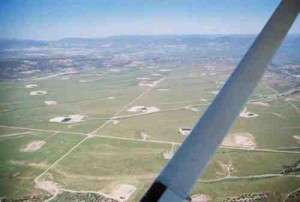Review by Virginia McConnell Simmons
History – April 2008 – Colorado Central Magazine
Radicalism in the Mountain West, 1890-1920: Socialists, Populists, Miners, and Wobblies
By David R. Berman
Published in 2007 by the University Press of Colorado
ISBN 978-0-87081-884-4
ALTHOUGH SOME HISTORIANS would argue that Andrew Jackson and his wing of the Democratic Party were the progenitors of an activist surge that rose against vested interests and championed small farmers and laborers at the end of the 19th century, David R. Berman specifically anchors the development of political radicalism in the West to the Populist and Socialist movements.
In his Preface to Radicalism in the Mountain West, 1890-1920, Berman states:
“[My] study focuses on (1) the relationship between Populism and Socialism and how both were related to the emergence of a streak of radicalism in the union movement, particularly in the mining areas; and (2) the development, characteristics, limitation, and accomplishments of Socialist party organizations in the area. Along the way I touch upon several themes of interest to western historians– free silver, labor relations, violence, woman suffrage, and Mormonism among them– and, for political scientists as well as historians, the utility of third parties as vehicles for change.”
This summary describes the book so well that a reviewer might simply note that Berman has accomplished his purpose skillfully and persuasively and stop there. I cannot refrain from observing, however, that Berman’s study will be of interest to many readers beyond the political scientists and historians to whom he refers. Granted, general readers will need a little tenacity, for Radicalism in the Mountain West, 1890-1920, is not a page-turner.
With its focus on labor in the Mountain West, this volume offers little background about the growth of populism among impoverished farmers in the Midwest and High Plains. Likewise, woman suffrage, also an issue at the time, only enters the account peripherally, because female advocates of suffrage tended to engage in other reform battles. Well-known among them were writers, speakers, and peripatetic organizers and agitators who appear in Berman’s study, including Ida Crouch Hazlett and Mary “Mother” Jones.
In a chapter entitled “Fusion, Decline, Transition,” the issue of free silver is shown to be a watershed moment in the growing Populist movement in the 1890s. In 1892, Davis H. Waite was elected Colorado’s Populist governor, primarily with the support of farmers. Prior to 1896, fusionist Populists attempted to stay in the middle-of-the-road, attempting alliances with members of the existing Democratic Party when they shared common goals, or occasionally with the Social Democratic Party led by Eugene Debs. But after Waite supported miners in a strike at Cripple Creek, opposition labeled him a Socialist and managed to defeat him in 1894 and again in 1898. In the Presidential campaign of 1896, Populists and Democrats nominated William Jennings Bryan of the fiery “Cross of Gold” speech (he lost to William McKinley).
As Colorado history shows, by the turn of the century, a Democratic Party preoccupied with the machinery of winning and retaining offices had abandoned its liberal agenda, leaving radical movements in states like Colorado on their own.
WHEN ADVOCATES OF Socialism, Populism, and labor unions first arrived in the West, some territories had not yet achieved statehood, and most centers of population were small and remote. Their individualistic residents and workers became wage-earners grudgingly — if at all — and were reluctant at first to join organized unions. But, having done so, they shared antipathy for ethnic groups other than their own, strike breakers, and, particularly, corporate owners of railroads, mines, and other industries. The Populist and Socialist political parties in the Mountain West became increasingly radical in their anti-corporate reform efforts, and evolved along more radical lines than did those elsewhere in the country.
Names of the period’s extremist leaders, like Bill Haywood and Charles Moyer, and of unions like the Industrial Workers of the World (IWW), with its members called Wobblies, are indelibly engraved in the history of the Mountain West in the early 1900s.
Berman’s book encompasses Colorado, New Mexico, Arizona, Utah, Nevada, Montana, and Wyoming, and covers thirty years. It’s a lot of territory, containing more pertinent events and persons than could possibly be presented in one volume like Radicalism in the Mountain West. Consequently, the author has employed selectivity in his text.
Berman’s choices serve their purpose, but some of them are sure to disappoint Colorado Central readers — especially local history buffs. On one hand, for instance, a reader will find only short mentions of labor strikes and military intervention at Leadville’s mines, and no mention at all of lesser coal mines near Florence, Colorado, together with their strikebreakers. On the other hand, Cripple Creek and the interventions of Governors Davis Waite and James Peabody and the Ludlow Massacre are covered. The famous labor conflict at Bunker Hill and the Coeur d’Alene district in Idaho, receives what might be called inadequate attention, whereas coverage of labor troubles at Bisbee, Arizona, and its aftermath on the Mexican border are discussed in detail.
Nonetheless, Berman’s study offers a wealth of information about unions and union leaders, and their often-violent conflicts with corporations and moneyed interests, as well as illuminating accounts of Populism and Socialism.
Tucked in here and there in this book are a score of photographs. Several are portraits of well-known figures and scenes such as the ruins at Ludlow. More revealing than the proverbial 1,000 words, images show agitator Mother Jones, looking like a tight-lipped warrior ready for battle; Bill Haywood, looking more like a hardware salesman than the macho figure I expected; an alarmingly thin Eugene Debs, grinning as he stepped from prison in 1921; and George W.P Hunt, a governor of Arizona who was called a traitor for supporting Mexican laborers during a strike, pictured here benignly knitting what appears to be a stocking beneath a portrait of Woodrow Wilson and a flag of the United States.
During the second decade of the 1900s, patriotic fervor associated with World War I increased opposition to radical activities, and the Bolshevik Revolution consigned radical movements to the realm of subversion in the public view.
Berman’s book will give readers a valuable perspective about the evolution of radical movements– whether they be related to racism, McCarthyism, protectionism, terrorism, extreme environmentalism, or other special interests.
THE AUTHOR DESERVES generous thanks not only for the information presented in this book but also for the possible effect of prompting readers to think about and compare bipartisan efforts in Congress which blurred the lines between the left and the right in the past with similar efforts today. It’s also fascinating to contrast political candidates of that period with those who adopt the tag of Populism in 2008.
This volume will be an important resource for researchers who are working in political science and the history of our region. It contains 386 pages, including 49 pages of endnotes, an appendix with nine tables, a daunting list of references, and an index. When reading or using a book like Radicalism in the Mountain West, you can feel confident you’re in the competent hands of a master of his subject. David R. Berman’s formal credentials include professor emeritus of political science at Arizona State University and senior fellow at the Morrison Institute for Public Policy at ASU.


